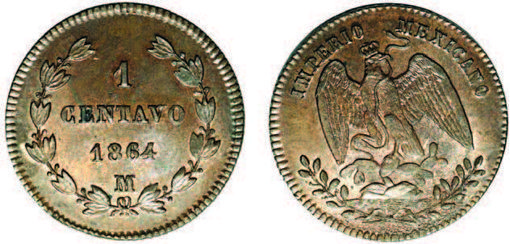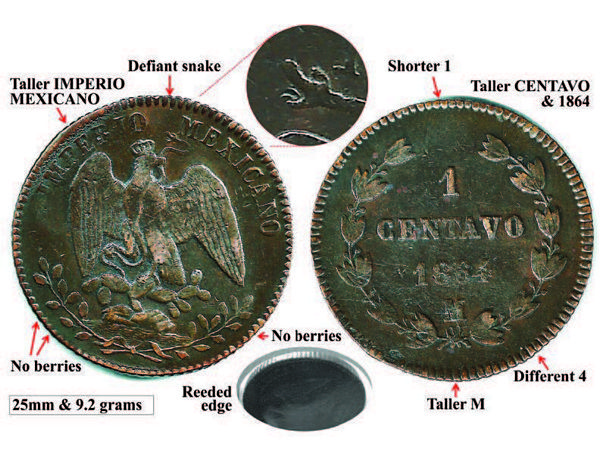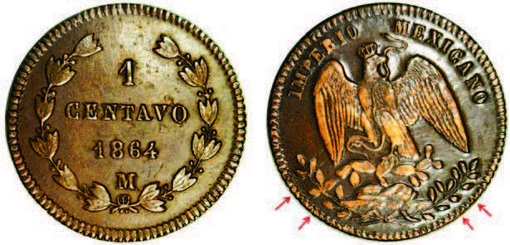The Defiant Snake variety of the 1864 Mexican Imperial Centavo
by Dr. Guzmán Sánchez-Schmitz
I started collecting the 1864 Mexican Imperial Centavo years ago, looking for that one coin that would confirm my hypothesis: I thought that, as an effective political strategy used before, the Mexican Second Empire would have demonetized the Republic 1863 centavo (KM390 & KM390.1) by using them as blanks for the new 1864 Imperial Centavo (KM384). After all, it is known that 1863 centavos were used as blanks for 1867 Cuartillas of San Luis Potosí. Being roughly of same weight (8.0-9.5grams), size (25-26.5mm), thickness (1.5mm), edge (reeded) and metal (copper), this idea seemed feasible, to say the least. In any case, making the story short, this was the reason why I started collecting these Centavos.
Based on surviving specimens known today it would seems that the 1864 Imperial Centavo was made only at Mexico City (mint mark M) and only during the year 1864. The father of Mexican numismatics, Dr. Alberto Francisco Pradeau, suspected that under the imperial regime other mint branches could have struck these centavosA. F. Pradeau. Emperor Maximilian I of Mexico, The French Intervention, Its History and that of its Coinage 1864-1867. The Maximilian Numismatic & Historical Society, 1970. In his monograph The mintages of 1864 at the Mexico City and Guanajuato Mints as published in the “Diario del Imperio” (official newspaper of the Empire), PradeauA. F. Pradeau, The mintages of 1864 at the Mexico City and Guanajuato Mints as published in the “Diario del Imperio” (official newspaper of the Empire) available in the USMexNA online library reproduces a month-by-month statement signed by José Antonio de Mendizabal in Mexico City on 31 December 1864 where the quantities of gold and silver coins produced at that mint were disclosed; but no copper coins, if struck at all that year, were reported here. As one would expect, the 1864 report from the mint of Guanajuato had no mention of copper coins minted there. On 6 July 1869 Mendizabal was still acting as Director of the Mexico City mint at the dawn of the Second Republic.
While neither a document nor a different date have surfaced today to prove this claim, several authors have mentioned the existence of an inventory account from the mint of Zacatecas done on 19 June 1876, listing a complete set of dies to strike the 1864 imperial one centavo in that mintPradeau, op. cit. note 1. Buttrey and Hubbard mention that these dies carried the Mexico City mint mark T. V. Buttrey and Clyde Hubbard. A guide book of Mexican Coins. 1822 to date. 2nd edition, 1971., while other authors maintain that it is still unknown if these dies bore an M or perhaps a new mint mark such as Z for ZacatecasGreg Meyer. The Republic One Centavo. 2nd edition, 2016.. Dr. Vogt, in his book Standard Catalog of Mexican Coins Dr. Geo. W. Vogt. Standard Catalog of Mexican Coins, Paper Money and Medals. Krause publications, 1978., highlights that the ship Novara, which brought Maximilian to Mexico, docked at Veracruz on 28 May 1864 and that by then the junta of Notables that established the Second Mexican Empire had already authorized the coinage of silver five and ten centavos at four mints across Mexico: Mexico City (M), Guanajuato (G), Zacatecas (Z) and San Luis Potosí (P). Nobody knows who ordered the Imperial Centavo in 1864 but Vogt insists: “The three coins, all of which bear an Imperial eagle on obverse and enwreathed value and date on reverse, are definitely coins of the Empire, but they are not coins of Maximilian”.
Despite the fact that its mintage remains a mystery, the Mexican Imperial Centavo is more common today than it was years ago, probably due to newly discovered hoards and the spreading use of underground coin-detecting technology. However, these coins are seldom found in good condition and high quality specimens are considered scarce. On top of environmental damage and circulation wear, many of these coins seem to have been produced with a deep flat-center and/or with worn-down/corroded dies. The general design of the Imperial Centavo consists of the legend: 1 / CENTAVO / 1864/ M — in four lines — within an open laurel wreath, on one side; and on the other side, a crowned Mexican eagle with a serpent in its beak and open wings, standing on a nopal cactus of eleven segments protruding from a rock on a lake; at the bottom, two olive branches tied up with a ribbon; and over the eagle, the legend IMPERIO MEXICANO (Mexican Empire).

Common type of 1864 Imperial centavo
Throughout my years of collecting I managed to acquire 24 specimens of the 1864 Mexican Imperial Centavo and, consequently, noticed some differences. This is not the first time varieties of the Imperial Centavo have been reported. Some catalogs state the existence of a smooth edge variety and MeyerMeyer, op. cit. describes four varieties based on the combination of edge, size of letters and the relative position of the numbers on the date:
• Type I. Reeded edge, aligned date and regular size letters (smaller than type IV).
• Type II. Reeded edge, left leaning 6 at date and regular size letters (as type I).
• Type III. Reeded edge and date with a high 6 and a 4 with the bottom serif slanted up to the left (letter size here is assumed to be same as type I and II).
• Type IV. Smooth edge, large letters “CENTAVO” (specially a longer “C”), taller numbers at date and taller mint mark.
Indeed, when quality permits, even with a small cohort of specimens one can infer small variations in the relative position and size of these elements on the design. Positional changes normally represent the use of new dies rather than the use of divergent punches. Nonetheless, when dramatic, this kind of varieties can be of great interest to collectors. Unfortunately for me, due the bad condition of most of my affordable specimens, performing the kind of measurements to follow previous classification would require caliper precision, a microscope, a great camera, proper software and, most importantly, specimens in great condition.
Besides the tiny changes in size and relative position of constant elements of the design, the 1864 Imperial Centavo has other more exciting and obvious changes. Based on the use of clearly distinctive new punches and the disappearance of regularly present elements I have found two varieties — both previously unreported — that I have named the “Defiant Snake” variety and the “Missing Berries” variety, to distinguish them from the Common Type centavo.
The Defiant Snake variety
Why name it Defiant Snake? For the same reason other important coin varieties have been named as such: it shows a biting-back open-mouth snake. This almost cartoonish snake head, with an open mouth, tongue and protruding eyes, is a very distinctive element as compared to the passive snake head of the Common Type. I have knowledge of only three specimens of the Defiant Snake variety.
 Defiant-Snake variety of 1864 Mexican Imperial Centavo (personal collection)
Defiant-Snake variety of 1864 Mexican Imperial Centavo (personal collection)
Besides its unusual snake head, the Defiant-Snake Imperial Centavo has other very distinctive and obvious features including: missing berries on the eagle-side, taller than normal letters on IMPERIO MEXICANO, CENTAVO, 1864 and the mint mark M, a shorter than normal value number 1, and a date number 4 of very different style than usual (with a big tail pointing up). The two specimens of this variety in my collection are both reeded edge.
The Common Type of 1864 Mexican Imperial Centavo (shown at the beginning) is perhaps the most frequent type found. It has berries on the eagle-side, a passive snake head (closed mouth with extending tongue and no protruding eyes), shorter letters on IMPERIO MEXICANO, CENTAVO, 1864 and the mint mark M, a taller value number 1, and the regular style of number 4 on date (with no big tail pointing up). All 18 examples of this Common Type in my collection are reeded edge.
The MIssing Berries variety

Missing Berries variety of the 1864 Mexica Imperial Centavo
(Banco de México)
The Missing-Berries variety of the 1864 Mexican Imperial Centavo, as its name suggests, has no berries on the eagleside. The remaining features seems to be the same occurring in the Common Type: a passive snake head (closed mouth with extending tongue and no protruding eyes), shorter letters on IMPERIO MEXICANO, CENTAVO, 1864 and the mint mark M, a taller value number 1, and the regular style of number 4 on date (with no big tail pointing up). I have three examples of this Missing-Berries variety and all of them are reeded edge.
I never have seen a smooth edge specimen of the Imperial Centavo. All of my 24 specimens have reeded edges of different degrees. I have noticed different separation lengths between the lines, suggesting a potential classification into fine versus coarse reeded edges; also, I have noticed that some coins seem intentionally tooled/scratched to remove the lines, leaving an arched edge. I am not sure of the meaning of these differences. At one point I thought this could be connected with my hypothesis, where these changes in lines would refer to a potential overlapping of reeded edge
remnants of a host 1863 Republic Centavo.
Regarding a potential order of issuing, there are no clear elements that would help rank them except perhaps the Defiant-Snake. Coins of Maximilian made in 1866 and 1867 (with his bust), such as the gold 20 pesos and the silver 1 peso and 50 cents, have all a clear Defiant-Snake in the coat of arms, that is, a snake with open mouth with tongue and eyes. Interestingly, the Defiant Snake head was such an important coin design that the Second Mexican Republic maintained it on its Centavo design for decades (1868-1897) after the defeat of Maximilian.
The fact that the two varieties we are reporting here share the same feature of no berries on the eagle side enables the possibility of finding new unreported varieties based on the combination of other single features. Also, because they share this feature these varieties may be closer in time-sequence than the Common Type.
Could it be that the Defiant-Snake variety was actually minted in another than the Mexico City mint, as it happened to the 1859 Sonora Cuartilla minted in Culiacán? Could it be that it was minted later (1866-1867) with the approval of Maximilian, as he may have done for the silver coins with his bust?
